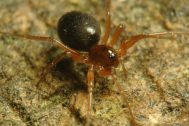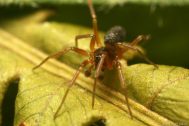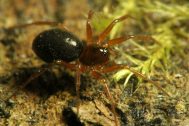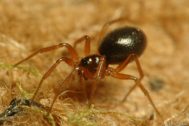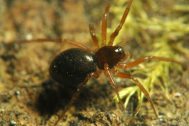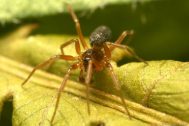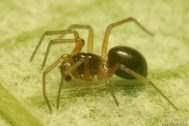| Nálezy podle období | |||||
|---|---|---|---|---|---|
| Linyphiidae | 0-1900 | 1901-1950 | 1951-2000 | 2001+ | ∑ |
| Oedothorax apicatus (Blackwall, 1850) Není ohrožený | 2× | 6× | 492× | 225× | 725× |
Oedothorax apicatus (Blackwall, 1850)
| České jméno | pavučenka rolní |
|---|---|
| Stupeň ohrožení | Není ohrožený |
| Nálezy | 725 nálezů, 176 kvadrátů |
| První nález |
1873, A. Palliardi, Nosek 1895 |
| Poslední nález | 2025 , Aleš Prágr |
| Areál rozšíření | Palaearctic - E-T |
| Fytogeografická oblast |
|
| Původnost stanovišť |
|
| Vlhkost stanovišť |
|
| Stratum |
|
| Osvětlení stanovišť |
|
| Hojnost výskytu |
|
| Nadm. výška | 150-1550 |
Literatura
Intense game grazing shapes epigeic spider communities of pedunculate oak Quercus robur plantations in anthropogenic environments
Game browsing affects nature conservation because the interests of hunters and gamekeepers often lead to high game stocking rates. However, the compositional effects of game browsing on invertebrates are insufficiently understood. We addressed the dynamics of epigeic spider communities in oak stands planted in newly formed anthropogenic environments under the facultative pressure of browsing game. The study site consisted of an open-cast lignite mine and an overburden deposit in NW Czechia. Using pitfall traps, we examined five habitat types (four transects per habitat type): Quercus robur stands ≥ 25 years of age, 12–24 years of age, and 0–2 years of age; Q. robur stands 12–24 years of age that were heavily damaged by game browsing; and sites subject to spontaneous succession for 12–22 years. We captured 9459 individuals from 134 spider species distributed unevenly across the examined habitat types. The young stands were dominated by Pardosa agrestis, Pardosa monticola, and Oedothorax apicatus, whereas Pardosa prativaga, Pardosa lugubris, Pisaura mirabilis, and Alopecosa cuneata dominated the old stands. The stands damaged by browsing had the highest species richness and were dominated by Alopecosa pulverulenta, Xerolycosa miniata, Alopecosa cuneata, and Trochosa ruricola. All the oak stands were rich in threatened species, with most (26) found in habitats damaged by browsing, whereas the youngest stands hosted the lowest number of threatened species (11). The species dominating old stands still included species that prefer greater canopy openness, such as Pardosa lugubris, whereas numerous species of central European climax oak forests were lacking. In conclusion, we identified oak stands heavily damaged by game browsing as a unique environment that shapes the community of epigeic spiders and that differs from epigeic spider communities of oak stands of various ages and those colonizing areas that are allowed to undergo spontaneous succession.
Neonicotinoid insecticides limit the potential of spiders to re-colonize disturbed agroecosystems when using silk-mediated dispersal
Agroecosystems are subject to regular disturbances that cause extinction or migration of much of their fauna, followed by recolonization from surrounding refuges. In small-sized aeronaut spiders, such recolonization is potentiated by their ability to rappel and balloon. These are complex behaviors that we hypothesized to be affected by neurotoxins, namely, neonicotinoids. We tested this hypothesis using two common farmland spider species, Oedothorax apicatus (Linyphiidae) and Phylloneta impressa (Theridiidae). The spiders were topically exposed by dorsal wet application or tarsal dry exposure to commercial neonicotinoid formulations Actara 25 WG, Biscaya 240 OD, Mospilan 20 SP and Confidor 200 OD at concentrations that are recommended for application in agriculture. Contact exposure to neonicotinoids suppressed the ability of spiders to produce the major ampullate fiber and anchor it to the substratum by piriform fibrils. Contact exposure to neonicotinoids also suppressed the ballooning behavior that was manifested by climbing to elevated places, adopting a tiptoe position and producing silk gossamer in the wind. Impaired ability of affected common farmland spiders to quickly recolonize disturbed agroecosystems by silk-mediated dispersal may explain their decline in multiple farmland ecosystems, in which neonicotinoids are applied.Fotografie
Statistiky
Dle měsíce v roce
Dle nadmořské výšky
Dle metody sběru (725 použitých nálezů)
| Oedothorax apicatus (Blackwall, 1850) ES | Samci | Samice | Mláďata | Nálezy |
|---|---|---|---|---|
| Smyk | 44 | 22 | 0 | 34 |
| Neurčeno | 292 | 129 | 47 | 159 |
| Zemní past | 8922 | 7303 | 53 | 424 |
| Prosev | 6 | 15 | 0 | 6 |
| Individuální sběr | 95 | 226 | 2 | 76 |
| Sklepávání | 10 | 8 | 0 | 14 |
| Vysavač | 3 | 0 | 0 | 1 |
| Žlutá miska | 7 | 2 | 0 | 8 |
| Eklektor | 2 | 2 | 0 | 3 |
| Samci | Samice | Mláďata | Nálezy |
Dle biotopu (725 použitých nálezů)
| Oedothorax apicatus (Blackwall, 1850) ES | Samci | Samice | Mláďata | Nálezy |
|---|---|---|---|---|
| Rákosiny a orobincové porosty stojatých vod | 0 | 2 | 0 | 3 |
| Stepi, vřesoviště, písčiny | 2 | 0 | 0 | 2 |
| Neurčeno | 6444 | 3777 | 52 | 299 |
| Bylinné porosty břehů | 5 | 16 | 0 | 4 |
| Rašeliniště | 10 | 2 | 0 | 8 |
| Širokolisté horské nivy | 1 | 0 | 0 | 1 |
| Kamenolomy | 10 | 36 | 0 | 11 |
| Suché louky | 15 | 20 | 0 | 15 |
| Štěrkové břehy řek | 0 | 4 | 0 | 1 |
| Suché křoviny | 6 | 1 | 0 | 5 |
| Těžebny písku a jiných nezpevněných hornin | 12 | 14 | 0 | 8 |
| Lužní lesy nížin | 332 | 240 | 0 | 33 |
| Louky | 0 | 0 | 0 | 1 |
| Mezofilní louky | 11 | 42 | 0 | 13 |
| Vrbové křoviny - vlhké (vrbové) křoviny | 2 | 1 | 0 | 3 |
| Ruderály | 42 | 65 | 0 | 25 |
| Suché lesní lemy | 4 | 0 | 0 | 1 |
| Paseky | 3 | 0 | 0 | 2 |
| Louky | 109 | 187 | 0 | 17 |
| Písčité břehy | 9 | 23 | 0 | 4 |
| Výsadby listnáčů | 4 | 1 | 0 | 4 |
| Ostatní pole | 1936 | 2583 | 50 | 69 |
| Slaniska | 2 | 1 | 0 | 3 |
| Obilná pole | 9 | 1 | 0 | 2 |
| Mokré louky | 37 | 72 | 0 | 32 |
| Kukuřičná pole | 5 | 8 | 0 | 2 |
| Kamenité břehy potoků | 102 | 49 | 0 | 6 |
| Suché doubravy | 9 | 11 | 0 | 2 |
| Vnější stěny budov | 1 | 1 | 0 | 2 |
| Bahnité břehy | 0 | 3 | 0 | 2 |
| Mokřady | 1 | 1 | 0 | 2 |
| Lesní okraje | 5 | 2 | 0 | 7 |
| Stinné skály nižších poloh | 2 | 2 | 0 | 4 |
| Okraje silnic | 0 | 1 | 0 | 1 |
| Xerotermní travinobylinná společenstva | 3 | 2 | 0 | 4 |
| Kamenité suti nižších poloh | 18 | 5 | 0 | 13 |
| Luční ostřicové mokřady | 2 | 0 | 0 | 2 |
| Ostřicové porosty stojatých vod | 2 | 1 | 0 | 2 |
| Výsadby jehličnanů | 2 | 7 | 0 | 5 |
| Suťové a roklinové lesy | 3 | 1 | 0 | 1 |
| Bučiny nižších poloh | 2 | 0 | 0 | 2 |
| Horské biotopy | 1 | 0 | 0 | 1 |
| Močály | 11 | 1 | 0 | 4 |
| Vlhké lesní lemy | 5 | 0 | 0 | 1 |
| Pastviny | 10 | 12 | 0 | 8 |
| Ovocné sady s luční vegetací | 65 | 92 | 0 | 26 |
| Břehy tekoucích vod | 17 | 86 | 0 | 18 |
| Mokřadní olšiny | 2 | 0 | 0 | 2 |
| Lesy vyšších poloh a strmých svahů | 1 | 1 | 0 | 2 |
| Přirozené lesy | 2 | 0 | 0 | 2 |
| Porosty borůvek | 1 | 1 | 0 | 2 |
| Haldy a výsypky | 2 | 3 | 0 | 5 |
| Lesostepní doubravy | 5 | 0 | 0 | 3 |
| Polní biotopy | 14 | 297 | 0 | 7 |
| alpínské trávníky | 9 | 3 | 0 | 9 |
| Lesy | 2 | 1 | 0 | 1 |
| Úhory | 65 | 26 | 0 | 5 |
| Dubohabřiny | 4 | 0 | 0 | 1 |
| Stojaté a pomalu tekoucí vody | 2 | 0 | 0 | 2 |
| Horské bučiny | 1 | 0 | 0 | 1 |
| Skalní stepi na vápenci | 0 | 2 | 0 | 2 |
| Samci | Samice | Mláďata | Nálezy |



